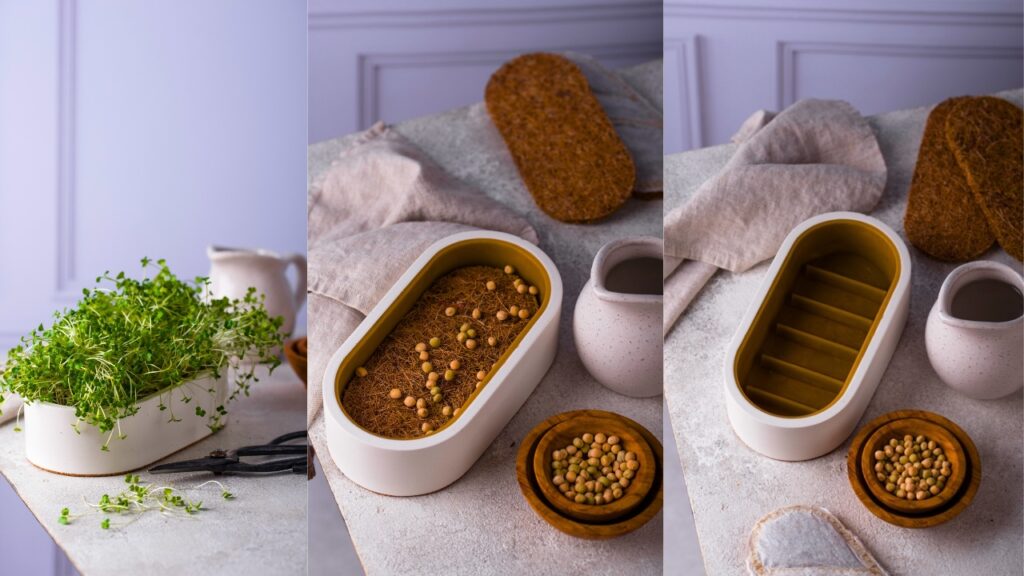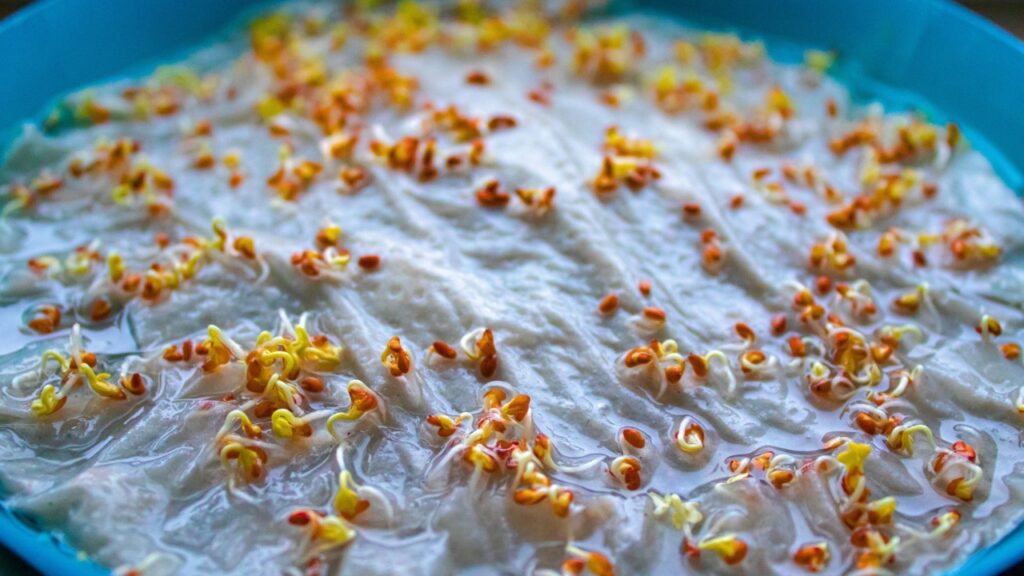It’s getting cold outside, so everyone wants to stay warm. The days we can’t wait for: the ones with hot tea and blankets.
Things get a little worse for our plants when the weather gets cold and the clouds get dark.
On the verge of winter, fresh vegetables that were just picked may seem like a faraway dream. Don’t worry. It’s easy to grow your favorite microgreens inside, where the conditions are managed.
Microgreens are tiny vegetable shoots that are very tasty and full of good things for you. These are plants that are usually picked when their true leaves show. You can grow healthy food without spending a lot of money by growing microgreens. And since you’re going to grow your microgreens inside, you can still pick them in the winter with a little work. Here are some tips on how to grow microgreens in the winter:
Important Things To Remember:
The two main environmental factors that will affect the growth of your microgreens in the fall and winter are lower temperatures and less light. These are the things you need to think about and focus on in your own growth place.
Since October in the UK, here’s where to grow your microgreens during the winter.
In a few words, somewhere warm! As most of us grow microgreens indoors all year, having the heat on in the winter can help because you’re growing in your house. As the weather gets warmer in the spring and summer, some plants are grown outside in greenhouses, polytunnels, or outbuildings.
This is great and easy to do. When it comes to growing microgreens for business in the UK winter (from October to April), I wouldn’t suggest it unless you have a heated and well-insulated outdoor area.
Natural light levels will drop below 10 hours a day and temps will drop below 15C. Your microgreens will still grow, but they will do so much more slowly, and the quality of their growth and the length of their growth cycles will become much less consistent. A nightmare if you want to grow them to sell to people regularly.
Grow Inside To Keep Out The Cold.

Winds that are cold and strong in the winter can hurt plant growth. You can grow your microgreens inside to keep them safe from harsh cold winds.
You don’t need a big pot to grow microgreens inside in the winter. To grow your microgreens, all you will need is a small tray that is one inch deep. Make sure that your potting tray has drainage holes so that water can escape. Also, keep an extra one under it to protect the surfaces from getting wet.
How Hot or Cold Should It Be?

The temperatures in your growth area should stay the same most of the time for your microgreens to grow well. When you grow for business, this is especially important because you will have schedules (like harvest and delivery days) and need to know exactly how long each crop needs to grow in your grow room.
The best temperature is 22 C. Most plants like it this warm, and you can quickly turn them over when it’s this warm. Most homes aren’t really this warm in the cold, and that’s fine. Just figure out how long plants need to grow at the temperatures you have. If your room temperature doesn’t usually rise above 18 C during the day, you should try to raise it.
In the greenhouse at the back of our house (see above), I ran my farm for three years as a business. There was a lot of glass, which let in a lot of natural light but didn’t do much to keep the temperature stable.
To save money, I didn’t heat it at night, so in the winter, the temperature went from 3C at night to 30C during the day when the sun came out! It wasn’t perfect, but it did the job. Almost.
I had to keep changing my growth cycles to adapt to the changing weather, but it helped me get my business off the ground and keep it growing during this time.
The main point of this post is that there are good conditions for growing microgreens for business in the winter, but it’s also possible to do it without them, especially if you’re just starting out and want to keep your costs as low as possible.
To Facilitate Germination, Soak The Seeds

It can be hard for seeds to germinate in the winter. So, letting the microgreen seeds soak overnight will help them sprout faster. Sunlight is not needed for seeds to sprout, but warm, misty dirt helps the sprouting process go faster. You can put your tray on heating mats until the seeds start to grow to give them extra heat in the winter. Spray water on your dirt gently two or three times a day to keep it moist.
Conditions for your seed to sprout in the winter

Making sure your microgreens seeds can grow is very important, and it’s even more important in the winter. It’s important that all of the seeds in your tray sprout at the same time.
That way, they should all grow at the same speed. When it’s time to pick, it will be much faster and easier if they’re all the same length. If it gets below 17 C in your grow room, I recommend moving the seeds to a warmer spot. Your grow room might be bigger than this room in your house.
Seeds that are germinating need the sun for sure. It took me a while to find a place to stack all of my grow trays, so I had to start my seeds in a kitchen cupboard.
But be careful not to heat them too much, either. Too much heat can cause mold to grow, seeds to die, and the grow medium to dry out. Don’t put them on heaters, then! Also, be careful if you decide to do this with heat mats.
Low Natural Light? Use Grow Lights

In the winter, it can be hard to find direct sunlight. Once the seeds begin to sprout, you will need to move the tray to a window sill so the microgreens can get indirect sunlight. But if you don’t get enough sunlight where you live, you can use grow lights to help your microgreens grow. As an alternative to sunshine, a grow light is an electric light that gives your plant the exact spectrum of light it needs. Plus, it can be useful when the clouds cover the sun.
Prevent Mold Growth

While it’s dark outside, your microgreens can get moldy in the winter. This issue happens when there isn’t enough air flow or the potted soil is too wet. If you don’t want mold to grow on your microgreens in the winter, you can cover them with cheesecloth instead of glass. This will allow air movement and prevent your microgreens from mold. Lastly, make sure the dirt is damp, not soaking wet.
In 2-3 Weeks, Harvest

If you plant microgreens inside during the winter, you can gather them in two to three weeks. Gather the crops as soon as the real leaves show up. Cut the plant just above the ground with scissors. Microgreens can be kept in the fridge for two to three days. However, it’s best eaten fresh. If you want to grow more microgreens, you can use the same watering tray to make a new micro-farm with fresh seeds.
When you see how easy it is to grow microgreens at home, you’ll want to do it all year long.
Insulation—Energy-Saving Necessity!
Keep warm, keep warm, keep warm! When you first start your business (or at any time if you haven’t already!), one of the best things you can do with your money and time is to make your room as well-insulated as possible. As the cost of energy in the UK rises, the last thing you want is to pay for costly heat that is lost to the outside and not used to grow your plants. Anything you can do to keep heat in during the winter will be worth the time and money. Fill in any holes and think about adding an extra layer of insulation to your walls.By the way, I’m not ignoring the fact that energy prices are going through the roof. This is something that our microgreens businesses need to think about and change, so it will get its own post next week.
Using Refrigerators In The Winter
One last thing about fridges: make sure they work right so that your microgreens don’t get frozen when it starts to get cold outside! One night, my microgreens froze to mush because I kept them in a fridge in our outside garage, which isn’t sealed.
If you need to set a temperature, 5C is fine for keeping microgreens cool. A fridge thermometer can help you keep an eye on this.
Finally, don’t put your picked microgreens punnets too close to the back of the fridge. That’s my last top tip for this week. Once more, they could freeze and turn into mush!

